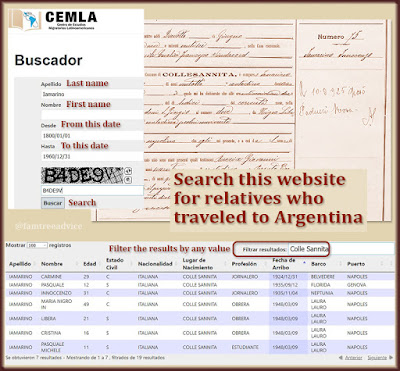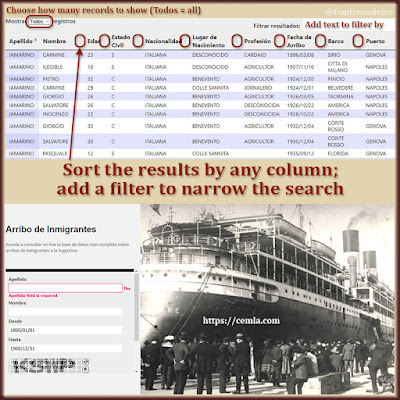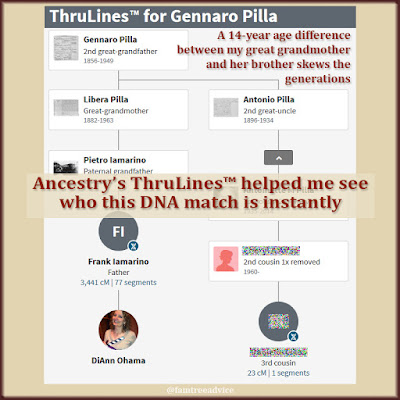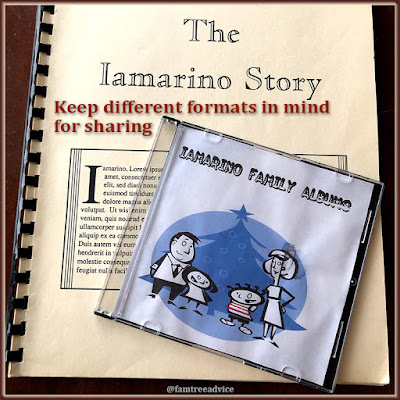There are online tools to help you identify family members who went to Argentina and Brazil. Recently we looked at Brazilian documents with photos of my Italian townspeople. Today we'll look at another resource to find family members who went to Argentina.
CEMLA is the Centro de Estudios Migratorios Latinoamericanos (Center for Latin American Migratory Studies). Their website offers a simple search form where you can enter:
- Apellido (last name)
- Nombre (first name)
- A date range, Desde (from) and Hasta (until)
Type in the jumble of letters and numbers you see and click Buscar (search). (Tip: You may only have to enter the jumbled code the first time.)
The database:
- covers more than 75 years of immigration
- has more than 4.4 million names
- includes more than 200 countries.
But their website does not have the ship manifest images for us to see. That's disappointing, yes. But let's see what we can do with the information they do provide.
 |
| This simple search form can turn up a list of possible relatives for you. |
I searched for immigrants with my maiden name, Iamarino, and got 19 results. All 19 Iamarinos arrived in Argentina between 1896 and 1954.
You can open Google Translator in another browser tab to translate the immigrants' professions. I used it to make sure "desconocido" in the Place of Birth column means unknown. And I found that C or S in the "Estado Civil" column means Married (Casado) or Single (Soltero).
Let's see what we can do with this table of search results.
Click on any column in the search results to sort by that value. I clicked the "Fecha de Arribo" (Arrival Date) column. You can also type a value in the "Filtrar resultados" box to filter your results. I can type the town name of Colle Sannita in the box to filter by my ancestral hometown.
That leaves me with 7 people who came from Grandpa Iamarino's hometown. The first one, Carmine Iamarino, was 29 years old in 1924. I can search for him in the towns' 1895 birth records. These are available on the Antenati website, and I've downloaded them to my computer.
There is a Carmine Iamarino born in 1895 to Pasquale Iamarino and Orsola Marino. Is he in my family tree? I searched my tree for him, and he isn't there. Yet. His parents are in my tree, and his father Pasquale is my 2nd cousin 4 times removed.
That means Carmine, whom I've just learned sailed to Argentina in 1924, is my 3rd cousin 3 times removed. Now I can enter Carmine into my family tree with his 1895 birth record and his 1924 immigration facts. I'll use the CEMLA website as my source and add all the facts I see:
- Carmine was a married man in 1924
- He was a laborer
- He arrived in Argentina on 31 December 1924
- He sailed out of Naples on the ship Belvedere
Let's try another one. Innocenzo Iamarino arrived in Argentina in 1935 at the age of 31. I searched my vital records for Innocenzo Iamarino born in 1904 and found him. He isn't in my family tree yet, either. But his parents are. And he's a closer relative than my first search.
Innocenzo's father, Giuseppantonio Iamarino, is my 2nd great uncle. He's the brother of my great grandfather Francesco. Innocenzo, who I'll be putting into my tree immediately, is my 1st cousin twice removed. (He's Grandpa's 1st cousin.)
Innocenzo's birth record tells me he married Rosa Paolucci in 1925. I searched the CEMLA site to see if she followed her husband to Argentina. It looks like she did not, so Innocenzo probably earned money in South America and returned to his wife in Italy. (Tip: There is no button to start a new search, so refresh the page in your web browser.)
Did Innocenzo sail to Argentina more than once? I removed the Colle Sannita filter from my search. There is another result for an Innocenzo born in 1904. He arrived in Argentina in 1926, married, listing his hometown as Benevento. Benevento is both a city and the name of the province to which Colle Sannita belongs. I'm fairly confident that this is my same 1st cousin twice removed.
 |
| The search screen offers many controls to help you find your relatives. |
I'm eager to work through every Iamarino in this list. You can't use an asterisk or question mark in your search, but I know the usual misspellings of my maiden name. I search for Jamarino and found 10 more results, one of which lists Colle Sannita as their place of birth.
It's great to have this bit of information to add to the stories of my relatives. If you have family members who traveled to and from another country to work, try the CEMLA website. You, too, may find relatives who sailed to Argentina to support their families.




